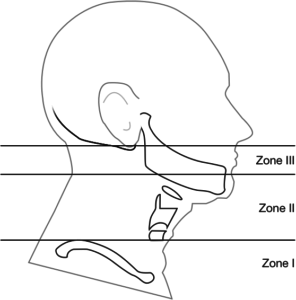Brief H&P
A young male presents to the emergency department after a self-inflicted stab wound to the neck. Examination revealed a knife handle protruding from the left lateral neck. A plain radiograph is shown below.
The patient was initially stable but developed shortness of breath upon attempting to lie flat for advanced imaging and was taken emergently to the operating room. Neck exploration showed no obvious neurovascular injuries, and the course of the 6cm blade was posterior to the trachea and esophagus. The knife was removed with “considerable force” as it was likely lodged within a portion of vertebral bone. The patient underwent esophagoscopy and bronchoscopy without identified tracheoesophageal injuries. The patient did well post-operatively and was discharged home.
Zones of Injury1-3
Previously, the evaluation and management of hemodynamically stable patients with penetrating neck injury was guided by the anatomic “zone” of injury. The affected zone guided the performance of additional diagnostic procedures including potentially morbid neck explorations.
Understanding zone definitions remains important for the emergency physician to appreciate potentially implicated underlying structures. However, the advent of modern imaging modalities, specifically computed tomography with angiography, provides appropriate sensitivity for vascular and tracheoesophageal injuries when combined with detailed physical examination and maintenance of an appropriate threshold for the performance of additional studies if warranted by the clinical presentation (suboptimal imaging, concerning projectile trajectory, etc).
| Zone | Definition |
|---|---|
| I | Clavicles/sternum to cricoid cartilage |
| II | Cricoid cartilage to the angle of mandible |
| III | Superior to the angle of mandible to the skull base |
Algorithm for the Evaluation of Penetrating Neck Trauma
References
- Sperry JL, Moore EE, Coimbra R, et al. Western Trauma Association critical decisions in trauma: penetrating neck trauma. J Trauma Acute Care Surg. 2013;75(6):936-940. doi:10.1097/TA.0b013e31829e20e3.
- Brywczynski JJ, Barrett TW, Lyon JA, Cotton BA. Management of penetrating neck injury in the emergency department: a structured literature review. Emerg Med J. 2008;25(11):711-715. doi:10.1136/emj.2008.058792.
- Shiroff AM, Gale SC, Martin ND, et al. Penetrating neck trauma: a review of management strategies and discussion of the “No Zone” approach. Am Surg. 2013;79(1):23-29. doi:10.1007/978-3-662-49859-0_29.



